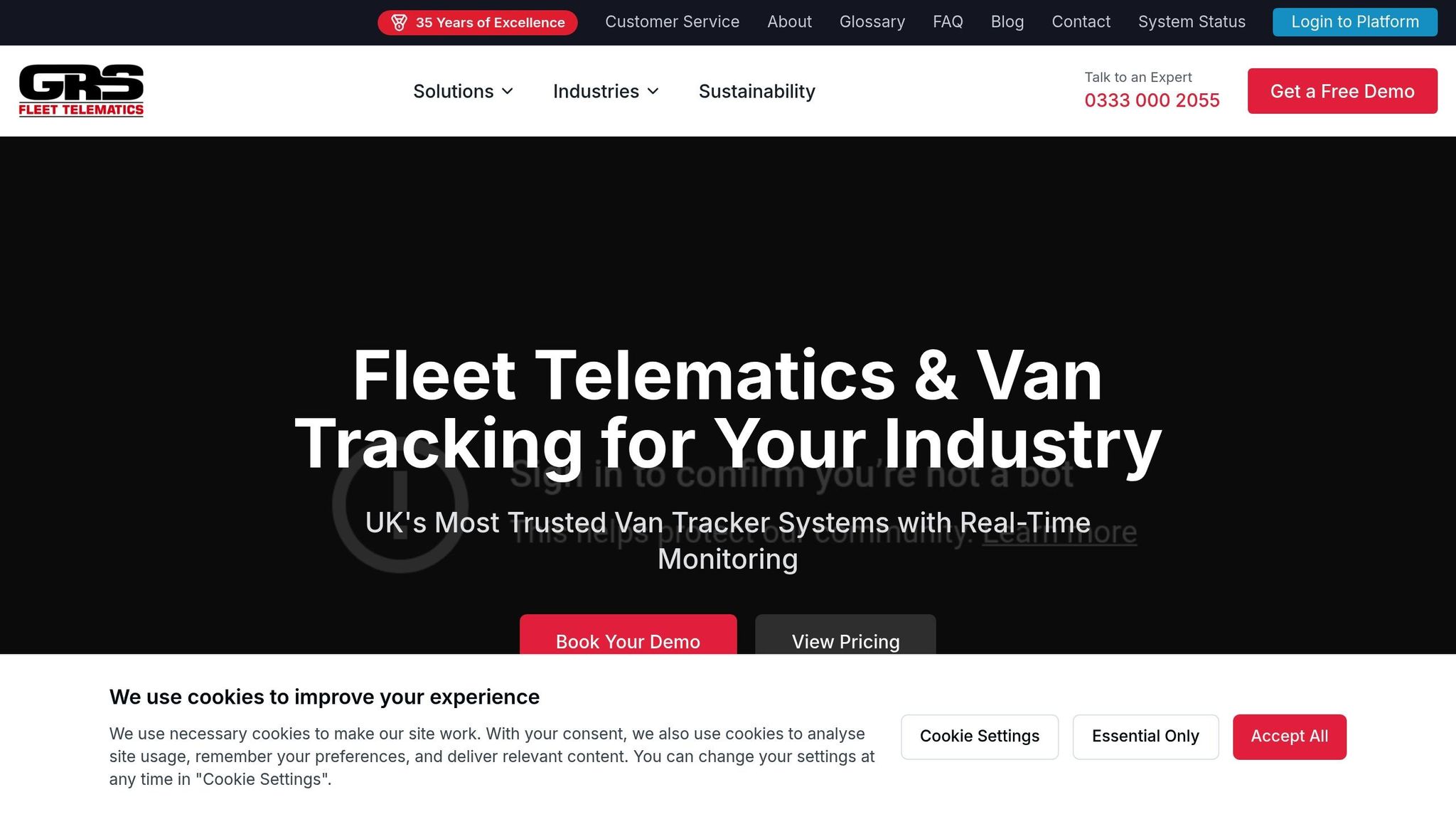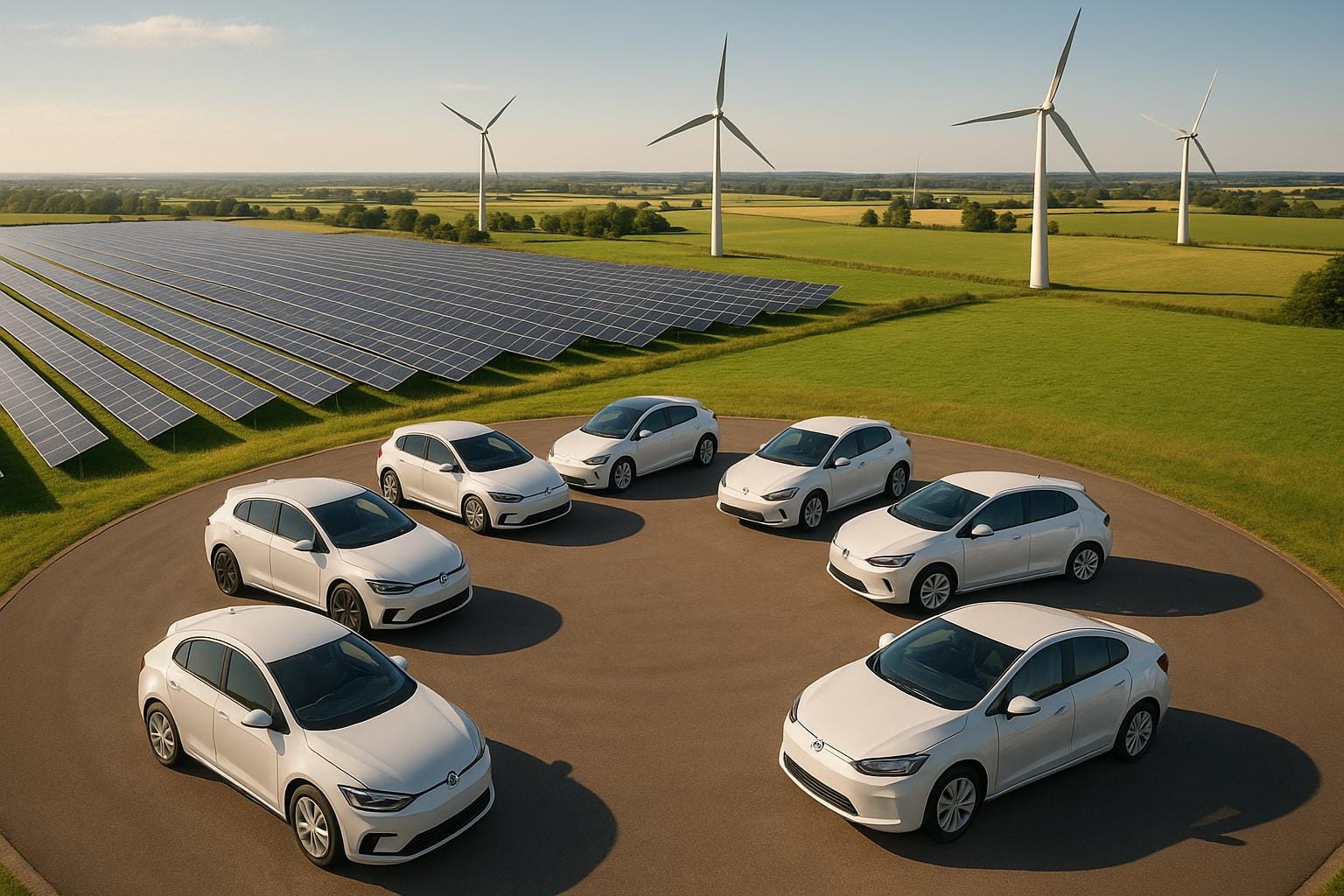Telematics systems are transforming fleet management in the UK by helping operators monitor and optimise renewable energy usage. These systems collect real-time data on energy consumption, vehicle performance, and emissions, enabling better decision-making and compliance with government targets. Here's why this matters:
- Cost Savings: Renewable energy sources like electricity, hydrogen, and biofuels often reduce long-term costs compared to petrol or diesel.
- Regulatory Compliance: Meeting UK carbon reduction goals is essential to qualify for grants and incentives.
- Customer Preference: Eco-conscious buyers increasingly favour businesses with strong sustainability practices.
Telematics bridges renewable energy and fleet management by tracking energy use, emissions, and maintenance needs. This data improves efficiency, supports route planning, and helps fleets transition to zero-emission vehicles while reducing their carbon footprint.
For example, telematics systems calculate emissions reductions by comparing baseline data with post-renewable adoption metrics. They also enable smart charging schedules to cut costs and align with renewable energy availability. As the UK National Grid aims for 100% renewable energy by 2035, telematics ensures fleets are well-prepared for this shift.
Whether it's monitoring EV battery levels, improving driver behaviour, or integrating renewable energy insights, telematics is key to reducing emissions and achieving fleet sustainability goals.
Exploring Telematics - a data driven approach to EV fleets
How Telematics Measures Emissions Reduction
Tracking the impact of renewable energy adoption on emissions requires precise data and analysis. Telematics systems provide fleet operators with the tools to monitor emissions reductions in detail, offering solid proof of sustainability efforts.
What Emissions Data Telematics Collects
Modern telematics systems gather crucial data on emissions, including CO₂ output, fuel consumption, and idling times, which are key indicators of fleet performance. They also monitor engine diagnostics, vehicle speed, acceleration habits, route efficiency, and driver behaviour - factors that directly affect emissions and vehicle efficiency.
For electric vehicles, telematics tracks battery state-of-charge, energy consumption trends, and charging habits. It also flags fault codes and maintenance alerts that could influence energy efficiency, enabling timely interventions to maintain optimal performance.
By capturing data in real time, telematics ensures emissions tracking reflects real-world conditions, factoring in variables like weather, traffic, and seasonal changes for a more accurate assessment.
How to Calculate Carbon Footprint Reduction
Using the emissions data collected, telematics systems calculate fleet carbon footprints, providing insights into the benefits of renewable energy adoption. These platforms compare baseline emissions with post-transition figures to quantify reductions and predict future improvements based on fleet upgrades.
For fleets with both conventional and renewable energy vehicles, telematics systems categorise emissions data by vehicle type, making it easier to attribute reductions to specific energy sources. Tools like the Electric Vehicle Evaluator leverage this data to support planning and sustainability reporting.
According to the UK Government's 2022 figures, the average energy mix from the National Grid emits 0.21302 kg CO₂ equivalent per kWh of electricity consumed. Telematics systems use such official data to ensure carbon footprint calculations align with regulations, particularly for scope 2 emissions reporting.
Automated reporting features further simplify compliance with frameworks like Streamlined Energy and Carbon Reporting (SECR). These reports provide clear documentation of environmental progress for stakeholders and regulators.
Measuring Fleet Sustainability Results
Armed with detailed emissions and usage data, telematics allows fleet operators to demonstrate measurable sustainability achievements. For instance, Madrid City Council equipped its EVs with Geotab GO devices in 2024 to monitor distance travelled, daily energy use, and average consumption. This data helped the council optimise its fleet size and implement a driver safety plan.
Similarly, a utilities provider in Ireland saw notable improvements after adopting telematics. The company cut speeding incidents in target zones by 76% and boosted safety scores by 6%, leading to reduced fuel consumption.
These examples highlight how cleaner energy sources, combined with telematics, drive continuous environmental improvements. By monitoring energy use, vehicle performance, and maintenance needs, operators can uncover further efficiency opportunities.
With the UK National Grid aiming to transition to 100% renewable energy by 2035, electric fleets are on track to achieve carbon neutrality for scope 2 emissions. Telematics provides fleet operators with the data framework needed to track and validate these environmental benefits.
Using Telematics to Improve Renewable Energy Efficiency
Telematics systems play a key role in maximising the efficiency of renewable energy by offering real-time insights that help reduce waste and improve overall performance.
Tracking Energy Consumption
Telematics platforms gather and analyse data from vehicle sensors, battery management systems, and charging infrastructure to monitor both real-time and historical energy usage. This includes tracking electricity consumption, charging events, and fuel usage in hybrid or alternative fuel vehicles. By identifying usage patterns, fleet managers can compare efficiency across different vehicle types and make informed decisions.
These systems capture critical details such as state of charge, energy consumption per trip, charging frequency, route profiles, and driver behaviour (e.g., acceleration and braking). Many platforms also feature unified dashboards that provide a comprehensive view of energy use per vehicle and across the fleet, enabling UK operators to pinpoint inefficiencies like excessive idling, poorly timed charging, or routes that drain batteries faster than expected.
Telematics also integrates seamlessly with charging infrastructure, offering real-time updates on charger status, energy delivered, and session timings. This connectivity allows fleet managers to coordinate charging schedules, avoiding peak electricity rates and balancing energy loads. For fleets relying on renewable energy, this level of control is crucial for efficient energy management.
With these insights, telematics systems pave the way for optimised route planning, cutting down on operational waste.
Planning Routes for Better Energy Use
Using GPS and real-time traffic data, telematics platforms help optimise routes to reduce unnecessary mileage and energy consumption, while keeping vehicles within their optimal range. For electric vehicles, routes can be planned to include charging points powered by renewable energy, minimising detours and avoiding congestion.
Smart route planning takes multiple factors into account, such as grid demand and renewable energy availability, to schedule charging during low-demand periods. This approach not only reduces costs but also aligns with sustainability goals. With the UK National Grid aiming for 100% renewable energy by 2035, this strategy supports the transition to carbon-neutral EV operations from a scope 2 emissions perspective.
Dynamic route adjustments further improve efficiency by responding to real-time conditions like traffic, weather, and charging station availability. This flexibility helps maintain optimal energy usage, even when unexpected challenges arise, avoiding the waste caused by inefficient route choices.
Additionally, the data gathered through route optimisation can inform long-term fleet strategies. By identifying routes that consistently demand more energy, fleet managers can adjust schedules or assign more efficient vehicles to handle those journeys, ensuring resources are used effectively.
Preventing Energy Waste Through Maintenance
Telematics systems also play a vital role in preventing energy waste through regular maintenance. Predictive maintenance, in particular, is a powerful tool for renewable-powered fleets. By tracking vehicle health indicators such as battery performance, tyre pressure, and motor efficiency, telematics can detect potential issues early on.
This early detection triggers maintenance alerts for problems like declining battery capacity or inefficient components, preventing breakdowns and ensuring vehicles operate at peak efficiency. Proactive maintenance reduces unplanned downtime and eliminates the extra energy costs associated with poorly maintained vehicles.
Real-time feedback from telematics systems also helps identify inefficient driving behaviours, such as excessive idling, which are major contributors to energy waste. Fleet managers can use this data to implement targeted driver training programmes, leading to measurable improvements in energy use and longer vehicle lifespans.
An example of this is GRS Fleet Telematics, which offers advanced tracking solutions to support maintenance and efficiency goals. With dual-tracker technology and analytics, fleet operators can monitor energy usage patterns while benefiting from a 91% recovery rate for stolen vehicles - all starting at just £7.99 per month.
Connecting Telematics with Renewable Energy Systems
Expanding on the topic of emissions tracking and efficiency, incorporating renewable energy data adds another layer to fleet sustainability. As fleet management evolves, operators are increasingly looking for ways to align with broader environmental goals. Traditional telematics solutions, like those offered by GRS Fleet Telematics, already provide valuable tools for vehicle tracking, security, and efficiency. While these systems don’t directly integrate with renewable energy platforms, the insights they provide can significantly shape effective sustainability strategies.
Using Telematics Data to Drive Sustainability
Even without direct links to renewable energy systems, telematics data plays a crucial role in reducing emissions. By focusing on areas such as route optimisation, idling reduction, and driver performance, telematics helps cut fuel consumption and lower emissions. Analysing real-time vehicle data allows fleet operators to pinpoint inefficiencies and make informed decisions to support their decarbonisation efforts.
Combining Telematics with Renewable Energy Insights
To fully harness the potential of renewable energy, fleet operators can complement telematics data with information from external energy sources. While GRS Fleet Telematics excels in delivering accurate tracking and operational metrics, pairing this data with insights from local energy suppliers or specialised energy management tools offers a more comprehensive picture of environmental impact. This dual approach enables fleet managers to make smarter, more sustainable decisions.
The Advantages of Integrated Data
Bringing together telematics and renewable energy data creates a powerful tool for sustainability reporting and operational planning. Real-time telematics insights enable proactive maintenance and smarter routing, reducing fuel usage and supporting the shift to cleaner energy sources. As fleets continue to prioritise decarbonisation, the combination of these data streams becomes a key factor in achieving renewable energy goals. This approach ensures a balanced and effective sustainability programme, aligning operational strategies with environmental objectives.
Case Study: GRS Fleet Telematics and Renewable Energy Impact

In the UK, fleets are increasingly turning to telematics to make their operations more efficient and environmentally friendly. GRS Fleet Telematics stands out as a key player in this space, offering solutions that go beyond standard vehicle tracking to support renewable energy initiatives.
GRS Fleet Telematics Features for Sustainability
One of the standout features of GRS Fleet Telematics is its real-time tracking, which provides instant insights into vehicle performance. This allows fleet operators to closely monitor energy consumption patterns, whether for traditional vehicles or electric alternatives. The platform's eco-driving analytics also plays a critical role by tracking driving behaviour and pinpointing inefficiencies, helping fleets cut down on unnecessary energy use.
The system's fleet analytics goes a step further by delivering detailed reports on fuel consumption, maintenance schedules, and overall performance. With this data, operators can manage energy use more effectively, ensuring their fleets run as efficiently as possible. Additionally, GRS Fleet Telematics employs route optimisation to reduce unnecessary mileage, tailoring solutions to the specific needs of each fleet and cutting down on wasted energy.
Improved Security and Efficiency for Green Fleets
GRS Fleet Telematics doesn't just focus on energy efficiency - it also enhances vehicle security. The platform's dual-tracker technology, which uses two independent devices per vehicle, has achieved a 91% recovery rate for stolen vehicles. This feature is particularly important for electric and hybrid vehicles, which are often high-value assets and attractive targets for theft.
On the financial side, GRS Fleet Telematics delivers measurable savings. Fleets can save £1,224.52 monthly or £14,694.25 annually, with a quick return on investment. The system also helps fleets save on energy costs by coordinating vehicle charging during off-peak hours, allowing operators to benefit from lower electricity tariffs. This not only reduces expenses but also helps lower the overall carbon footprint of fleet operations.
UK Fleet Success Stories
The impact of GRS Fleet Telematics is evident in the success stories of UK fleets. For example, a delivery company in London used the platform to monitor its electric vans and optimise charging schedules. Within a year, the company achieved an 18% reduction in fleet emissions by identifying inefficient routes and encouraging eco-friendly driving habits through the system’s behaviour monitoring tools.
Fleet operators across the UK have reported benefits such as better emissions tracking, lower fuel and energy costs, improved vehicle security, and easier compliance with environmental regulations. The detailed reporting capabilities of GRS Fleet Telematics have been particularly valuable for fleets needing to demonstrate progress towards sustainability goals. By providing data on energy use, trip distances, and charging events, the platform enables managers to calculate emissions reductions and present clear evidence of their efforts to meet environmental standards.
With pricing starting at just £7.99 per vehicle per month, GRS Fleet Telematics offers an affordable way for UK fleets to enhance their energy efficiency while maintaining top-notch security and operational performance.
Conclusion: What's Next for Telematics and Renewable Energy
As discussed, telematics plays a crucial role in reducing emissions and making renewable energy usage more efficient. Its integration is transforming the sustainability of UK fleets. With the National Grid aiming for 100% renewable energy by 2035, fleets adopting telematics today are setting the stage for achieving carbon neutrality in scope 2 emissions. These advancements highlight several important takeaways for fleet operators.
Key Takeaways
Telematics systems are at the heart of renewable energy fleet management, offering essential capabilities. Through real-time data collection, fleet managers can track energy consumption, evaluate charging efficiency, and calculate emissions reductions using the current UK grid emission factor of 0.21302 kg CO₂e per kWh. This data-driven strategy shifts fleet electrification from mere estimation to informed decision-making.
Practical examples show how telematics turns renewable energy use into tangible emissions reductions. Such cases illustrate the technology's ability to link renewable energy adoption with improved operational efficiency.
Additionally, with growing requirements to report scope 2 emissions under broader ESG frameworks, telematics provides the reliable, auditable data needed to meet these demands. The Energy Saving Trust has also identified telematics as a vital tool for transitioning to zero-emission vehicles.
What Lies Ahead
Looking forward, advancements in telematics will further enhance renewable energy efficiencies. Improved data analytics will enable predictive maintenance, while AI-driven route optimisation for EVs will account for factors like battery health, charging infrastructure, and real-time grid conditions.
One of the most anticipated developments is real-time integration with smart grids. This feature will allow fleets to automatically adjust charging schedules based on renewable energy availability, grid demand, and electricity pricing. The result? Lower energy costs and a more stable grid during peak renewable generation.
Greater compatibility with solar and wind energy systems will also be a game-changer. Telematics will help fleets coordinate vehicle charging with on-site renewable energy production, battery storage, and even grid exports. This approach will maximise both financial savings and environmental benefits.
These advancements promise to make renewable-powered fleet operations more dependable and cost-efficient. Fleet operators who adopt telematics solutions today will be in a prime position to leverage these emerging capabilities as they become available.
FAQs
How does telematics support the UK’s transition to 100% renewable energy by 2035?
Telematics is making a big difference in the UK's push towards renewable energy by keeping a close eye on fleet efficiency and finding ways to improve it. Platforms like GRS Fleet Telematics offer real-time insights into fuel consumption, emissions, and driver behaviour. This data allows businesses to fine-tune routes and cut down on fuel usage.
By streamlining operations and reducing environmental impact, telematics helps fleets stay in line with the UK's goals for renewable energy and cutting carbon emissions. Beyond supporting greener practices, these systems also help businesses save money in the process.
What data does telematics gather to help fleet operators reduce their carbon footprint?
Telematics systems, like those from GRS Fleet Telematics, gather essential data that supports fleet operators in managing and cutting down their carbon emissions. This includes detailed information on fuel consumption, which plays a major role in monitoring emissions, and vehicle usage patterns, helping to identify areas of inefficiency.
These systems also offer real-time location tracking, which allows for route optimisation. By reducing unnecessary mileage, operators can improve fuel efficiency and lower emissions. With this data at their fingertips, fleet managers are better equipped to make decisions that not only reduce their environmental impact but also improve day-to-day operations.
How do telematics systems help integrate renewable energy to improve fleet efficiency and cut costs?
Telematics systems are becoming increasingly important in helping businesses incorporate renewable energy into their fleet operations. These systems allow companies to monitor and analyse vehicle data, which can lead to smarter energy use, better performance tracking for electric or hybrid vehicles, and a clearer understanding of charging habits when using renewable energy sources.
For instance, telematics can pinpoint the most energy-efficient routes, reducing overall consumption. They can also schedule vehicle charging during off-peak electricity hours, cutting costs even further. Tools like GRS Fleet Telematics not only improve fleet security and performance but also support businesses in their move towards using cleaner energy solutions.

